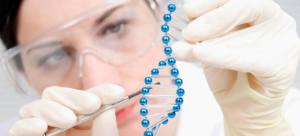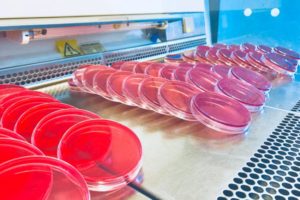Huntington’s Chorea Disease Specimens
Bay Biosciences provides high quality, clinical grade bio-samples, cryogenically preserved biopsy tissue, FFPE blocks, sera (serum), plasma and peripheral blood mononuclear cells (PBMC) biofluid specimens from patients diagnosed with Huntington’s Chorea Disease.
The sera (serum), plasma and PBMC biofluid samples are processed from patient’s peripheral whole-blood using customized collection and processing protocols. The Huntington’s Chorea Disease bio-specimens are collected from unique patients diagnosed with Huntington’s Disease and are provided to a valued pharmaceutical customer for research, development and drug discovery.

Huntington’s Disease (HD) Overview
Huntington’s Disease (HD) is a rare, inherited disorder that causes the progressive breakdown (degeneration) of nerve cells in the brain. Huntington’s disease has a broad impact on a person’s functional abilities and usually results in movement, thinking (cognitive) and psychiatric disorders. Huntington’s disease (HD) is a brain disease that is passed down in families from generation to generation. It is caused by a mistake in the DNA instructions that build our bodies and keep them running. DNA is made up of thousands of genes, and people with HD have a small error in one gene, called huntingtin. Huntington’s disease is a progressive brain disorder caused by a single defective gene on chromosome 4 one of the 23 human chromosomes that carry a person’s entire genetic code. Over time this error causes damage to the brain and leads to HD symptoms.
Huntington’s disease symptoms can develop at any time, but they often first appear when people are in their 30s or 40s. If the condition develops before age 20, it’s called juvenile Huntington’s disease. When Huntington’s develops early, symptoms are somewhat different and the disease may progress faster. HD causes deterioration in a person’s physical, mental, and emotional abilities, usually during their prime working years, and currently has no cure. Most people start developing symptoms during adulthood, between the ages of 30 to 50, but HD can also occur in children and young adults (known as juvenile HD or JHD). HD is known as a family disease because every child of a parent with HD has a 50/50 chance of inheriting the faulty gene.
Huntington’s Disease (HD) Symptoms
Huntington’s disease usually causes movement, cognitive and psychiatric disorders with a wide spectrum of signs and symptoms. Which symptoms appear first varies greatly from person to person. Some symptoms appear more dominant or have a greater effect on functional ability, but that can change throughout the course of the disease.
Movement Disorders
The movement disorders associated with Huntington’s disease can include both involuntary movement problems and impairments in voluntary movements, such as:
- Involuntary jerking or writhing movements (chorea)
- Muscle problems, such as rigidity or muscle contracture (dystonia)
- Slow or abnormal eye movements
- Impaired gait, posture and balance
- Difficulty with speech or swallowing
Impairments in voluntary movements rather than the involuntary movements may have a greater impact on a person’s ability to work, perform daily activities, communicate and remain independent.
Cognitive Disorders
Cognitive impairments often associated with Huntington’s disease include:
- Difficulty organizing, prioritizing or focusing on tasks
- Lack of flexibility or the tendency to get stuck on a thought, behavior or action (perseveration)
- Lack of impulse control that can result in outbursts, acting without thinking and sexual promiscuity
- Lack of awareness of one’s own behaviors and abilities
- Slowness in processing thoughts or ”finding” words
- Difficulty in learning new information

Psychiatric Disorders
The most common psychiatric disorder associated with Huntington’s disease is depression. This isn’t simply a reaction to receiving a diagnosis of Huntington’s disease. Instead, depression appears to occur because of injury to the brain and subsequent changes in brain function. Signs and symptoms may include:
- Feelings of irritability, sadness or apathy
- Social withdrawal
- Insomnia
- Fatigue and loss of energy
- Frequent thoughts of death, dying or suicide
Other common psychiatric disorders include:
- Obsessive-compulsive disorder, a condition marked by recurrent, intrusive thoughts and repetitive behaviors
- Mania, which can cause elevated mood, overactivity, impulsive behavior and inflated self-esteem
- Bipolar disorder, a condition with alternating episodes of depression and mania
In addition to the above disorders, weight loss is common in patients with Huntington’s disease, especially as the disease progresses.
Symptoms of Juvenile Huntington’s Disease (HD)
The start and progression of Huntington’s disease in younger patients may be slightly different from that in adults. Problems that often present early in the course of the disease include:
Behavioral Changes
- Difficulty paying attention
- Rapid, significant drop in overall school performance
- Behavioral problems
Physical Changes
- Contracted and rigid muscles that affect gait (especially in young children)
- Tremors or slight involuntary movements
- Frequent falls or clumsiness
- Seizures

Causes of Huntington’s Disease (HD)
Huntington’s disease is caused by an inherited disorder in a single gene. Huntington’s disease is an autosomal dominant disorder, which means that a person needs only one copy of the defective gene to develop the disorder. With the exception of genes on the sex chromosomes, a person inherits two copies of every gene, one copy from each parent. A parent with a defective gene could pass along the defective copy of the gene or the healthy copy. Each child in the family, therefore, has a 50% chance of inheriting the gene that causes the genetic disorder.
Huntington’s Disease (HD) Complications
Once Huntington’s disease develops, the patient’s functional abilities gradually worsen over time. The rate of disease progression and duration varies. The time from disease emergence to death is often between 10 to 30 years. Juvenile Huntington’s disease usually results in death within 10 years after symptoms develop. The clinical depression associated with Huntington’s disease may increase the risk of suicide. Some research suggests that the greater risk of suicide occurs before a diagnosis is made and in the middle stages of the disease when a person starts to lose independence.
Eventually, a patient with Huntington’s disease requires help with all activities of daily living and care. Late in the disease, he or she will likely be confined to a bed and unable to speak. Someone with Huntington’s disease is generally able to understand language and has an awareness of family and friends, though some won’t recognize family members.
Common causes of death include:
- Pneumonia or other infections
- Injuries related to falls
- Complications related to the inability to swallow
Prevention of Huntington’s Disease
Person’s with a known family history of Huntington’s disease are understandably concerned about whether they may pass the Huntington gene on to their children. These people may consider genetic testing and family planning options. If an at-risk parent is considering genetic testing, it can be helpful to meet with a genetic counselor. A genetic counselor will discuss the potential risks of a positive test result, which would indicate that the parent will develop the disease. Also, couples will need to make additional choices about whether to have children or to consider alternatives, such as prenatal testing for the gene or in vitro fertilization with donor sperm or eggs.
Another option for couples is in vitro fertilization and preimplantation genetic diagnosis. In this process, eggs are removed from the ovaries and fertilized with the father’s sperm in a laboratory. The embryos are tested for presence of the Huntington gene, and only those testing negative for the Huntington gene are implanted in the mother’s uterus.

Detailed clinical data and medical histories of the patients, along with MRI/CT scan, elevated biomarker levels, genetic testing information, pathology annotations associated with the Huntington’s Chorea Disease patient’s specimens is provided to a valued customer for research, development and drug discovery. The Huntington’s Disease sera (serum), plasma and peripheral blood mononuclear cells (PBMC) biofluid samples are processed from patients peripheral whole-blood using customized collection and processing protocols provided by the researcher.
Bay Biosciences is a global leader in providing researchers with high quality, clinical grade, fully characterized human tissue samples, bio-specimens and human bio-fluid collections from cancer (tumor) tissue, cancer sera (serum), cancer plasma, cancer PBMC and human tissue samples from most other therapeutic areas and diseases.
Bay Biosciences maintains and manages it’s own bio-repository, human tissue bank (biobank) consisting of thousands of diseased samples (specimens) and from normal healthy donors available in all formats and types. Our biobank procures and stores fully consented, deidentified and institutional review boards (IRB) approved human tissue samples and matched controls.
All our human human tissue collections, human specimens and human bio-fluids are provided with detailed samples associated patient’s clinical data. This critical patient’s clinical data includes information relating to their past and current disease, treatment history, lifestyle choices, biomarkers and genetic information. Patient’s data is extremely valuable for researchers and is used to help identify new effective treatments (drug discovery & development) in oncology, other therapeutic areas and diseases. This clinical information is critical to demonstrate their impact, monitor the safety of medicines, testing & diagnostics, and generate new knowledge about the causes of disease and illness.
Bay Biosciences banks wide variety of human tissue samples and biological samples including cryogenically preserved -80°C, fresh, fresh frozen tissue samples, tumor tissue samples, FFPE’s, tissue slides, with matching human bio-fluids, whole blood and blood derived products such as serum, plasma and PBMC’s.
Bay Biosciences is a global leader in collecting and providing human tissue samples according to the researchers specified requirements and customized, tailor made collection protocols. Please contact us anytime to discuss your special research projects and customized human tissue sample requirements.
Bay Biosciences provides human tissue samples (human specimens) from diseased and normal healthy donors; including peripheral whole-blood, amniotic fluid, bronchoalveolar lavage fluid (BAL), sputum, pleural effusion, cerebrospinal fluid (CSF), serum (sera), plasma, peripheral blood mononuclear cells (PBMC’s), saliva, Buffy coat, urine, stool samples, aqueous humor, vitreous humor, kidney stones, renal calculi, nephrolithiasis, urolithiasis and other bodily fluids from most diseases including cancer. We can also procure most human bio-specimens and can do special collections and requests of human samples that are difficult to find. All our human tissue samples are procured through IRB approved clinical protocols and procedures.
In addition to the standard processing protocols Bay Biosciences can also provide human plasma, serum, PBMC bio-fluid samples using custom processing protocols, you can buy donor specific sample collections in higher volumes and specified sample aliquoting from us. Bay Biosciences also provides human samples from normal healthy donors, volunteers, for controls and clinical research, contact us Now.
日本のお客様は、ベイバイオサイエンスジャパンBay Biosciences Japan またはhttp://baybiosciences-jp.com/contact/までご連絡ください。


